| Revision as of 22:21, 28 September 2014 edit187.126.203.14 (talk) →Infantry fighting vehicles and Armored personnel carriers← Previous edit | Revision as of 02:14, 1 October 2014 edit undoAgustin.leon21 (talk | contribs)99 edits →EquipmentTags: Mobile edit Mobile web editNext edit → | ||
| (2 intermediate revisions by the same user not shown) | |||
| Line 431: | Line 431: | ||
| ! Photo | ! Photo | ||
| |- | |- | ||
| | ] GAI B01 || 20 mm ] || |
| ] GAI B01 || 20 mm ] || 230 || {{FRA}} || Being automated || | ||
| |- | |- | ||
| | ] || 40 mm anti-aircraft gun || |
| ] || 40 mm anti-aircraft gun || 262 || {{SWE}} || || ] | ||
| |- | |- | ||
| | ] || 35 mm anti-aircraft gun || |
| ] || 35 mm anti-aircraft gun || 38 || {{SUI}} || || ] | ||
| |- | |- | ||
| | ] || ] system || 12 || {{SWE}} || To be acquired<ref name="artillery"/> || ] | | ] || ] system || 12 || {{SWE}} || To be acquired<ref name="artillery"/> || ] | ||
| |- | |- | ||
| | ] || ] system || 3 || {{FRA}} || || ] | | ] || ] system || 3 || {{FRA}} || will be replaced by the ] || ] | ||
| |- | |- | ||
| |} | |} | ||
Revision as of 02:14, 1 October 2014
| This article needs additional citations for verification. Please help improve this article by adding citations to reliable sources. Unsourced material may be challenged and removed. Find sources: "Argentine Army" – news · newspapers · books · scholar · JSTOR (January 2010) (Learn how and when to remove this message) |
| Argentine Army Ejército Argentino | |
|---|---|
| File:Ejército Argentino.svgArgentine Army Seal | |
| Active | 1810; 215 years ago (1810) |
| Country | |
| Branch | Army |
| Size | 44,230 active personnel (2014) 16,000 reservists (2014) |
| Part of | Ministry of Defence |
| Garrison/HQ | Buenos Aires |
| Anniversaries | May 29 (Argentine Army Day) |
| Equipment | 348 Main battle tanks 896 armored vehicles 771 artillery pieces 128 Self-propelled artillery 5,021 military vehicles 46 helicopters |
| Engagements | War of Independence (1810-1818) Spanish American wars of independence (1808–1833) Luso-Brazilian Invasion (1816) Cisplatine War (1825-1828) War of the Confederation (1836-1839) Uruguayan Civil War (1839-1852) Platine War (1851-1852) Paraguayan War (1864-1870) Conquest of the Desert (1870-1884) Operation Independence (1975-1976) Operation Soberanía (1978) Falklands War (1982) Gulf War (1990-1991) "U.N. missions" Bosnia (1992-1995) Cyprus (1993-present) Kosovo (1999-present) Haiti (2004-present) |
| Commanders | |
| Commander-in-Chief | President Cristina Fernández de Kirchner |
| Ceremonial chief | Army General César Milani |
The Argentine Army (Ejército Argentino, EA) is the land armed force branch of the Armed Forces of the Argentine Republic and the senior military service of the country. As of 2012, the active element of the Argentine army numbered some 38,500 military personnel. A reduction from over 44,000 personnel in 2010. Under the Argentine Constitution, the President of Argentina is the Commander-in-Chief of the Armed Forces, exercising his or her command authority through the Minister of Defense.
The Army's official foundation date is May 29, 1810 (celebrated in Argentina as the Army Day), four days after the Spanish colonial administration in Buenos Aires was overthrown. The new national army was formed out of several pre-existent colonial militia units and locally-manned regiments; most notoriously the Infantry Regiment "Patricios", which to this date is still an active unit. These units had previously fought the British invasions of the Río de la Plata in 1806 and 1807.
History

Several armed expeditions were sent to the Upper Peru (now Bolivia), Paraguay, Uruguay and Chile to fight Spanish forces and secure Argentina's newly gained independence. The most famous of these expeditions was the one led by General José de San Martín, who led a 5000-man army across the Andes Mountains to expel the Spaniards from Chile and later from Perú. While the other expeditions failed in their goal of bringing all the dependencies of the former Viceroyalty of the Río de la Plata under the new government in Buenos Aires, they prevented the Spaniards from crushing the rebellion.
During the civil wars of the first half of the 19th century the Argentine Army became fractionalized under the leadership of the so-called caudillos ("leaders" or "warlords"), provincial leaders who waged a war against the centralist Buenos Aires administration. However, the Army was briefly re-unified during the war with the Brazilian Empire. (1824–1827).
It was only with the establishment of a Constitution (which explicitly forbade the provinces from maintaining military forces of their own) and a national government recognized by all the provinces that the Army became a single force, absorbing the older provincial militias. The Army went on to fight the War of the Triple Alliance in the 1860s together with Brazil and Uruguay against Paraguay. After that war, the Army became involved in Argentina's Conquista del Desierto ("Conquest of the Desert"): the campaign to occupy Patagonia and root out the natives, who conducted looting raids throughout the country.
1880–1960s
Between 1880 and 1930 the Army sought to become a professional force without active involvement in politics, even though many a political figure -President Julio Argentino Roca, for example- benefitted from a past military career. The Army prevented the fall of the government in a number of Radical-led uprisings. Meanwhile, the military in general and the Army in particular contributed to develop Argentina's unsettled southern frontier and its nascent industrial complex.
The main foreign influence during this period was, by and large, the Prussian (and then German) doctrine. Partly because of that, during both World Wars most of the officers supported the Germans, more or less openly, while the Argentine Navy favored the British instead.
In 1930, a small group of Army forces (not more than 600 troops) deposed President Hipólito Yrigoyen without much response from the rest of the Army and the Navy. This was the beginning of a long history of political intervention by the military. Another coup, in 1943, was responsible for bringing an obscure colonel into the political limelight: Juan Perón.
Even though Perón had the support of the military during his two consecutive terms of office (1946–1952 and 1952–1955), his increasingly repressive government alienated many officers, which finally led to a military uprising which overthrew him in September 1955. Between 1955 and 1973 the Army and the rest of the military became vigilant over the possible re-emergence of Peronism in the political arena, which led to two new coups against elected Presidents in 1962 (deposing Arturo Frondizi) and 1966 (ousting Arturo Illia). It should be noted that political infighting eroded discipline and cohesion within the army, to the extent that there was armed fighting between contending military units during the early 1960s.
1960s and the military junta
The military government which ruled Argentina between 1966 and 1973 saw the growing activities of groups such as Montoneros and the ERP, and also a very important social movement. During Héctor Cámpora's first months of government, a rather moderate and left-wing Peronist, approximatively 600 social conflicts, strikes and factory occupations had taken place. Following the June 20, 1973 Ezeiza massacre, left and right-wing Peronism broke apart, while the Triple A death squad, organized by José López Rega, closest advisor to María Estela Martínez de Perón, started a campaign of assassinations against left-wing opponents. But Isabel Perón herself was ousted during the March 1976 coup by a military junta.
The new military government, self-named Proceso de Reorganización Nacional, put a stop to the guerrilla's campaigns, but soon it became known that extremely violent methods and severe violations of human rights had taken place, in what the dictatorship called a "Dirty War" — a term refused by jurists during the 1985 Trial of the Juntas. Batallón de Inteligencia 601 (the 601st Intelligence Battalion) became infamous during this period. It was a special military intelligence service set up in the late 1970s, active in the Dirty War and Operation Condor, and disbanded in 2000. Its personnel collected information on and infiltrated guerrilla groups and human rights organisations, and coordinated killings, kidnappings and other abuses. The unit also participated in the training of Nicaraguan Contras with US assistance, including from John Negroponte.
"Annihilation decrees"
Main article: Operativo Independencia
Meanwhile, the Guevarist People's Revolutionary Army (ERP), led by Roberto Santucho and inspired by Che Guevara's foco theory, began a rural insurgency in the province of Tucumán, in the mountainous northwest of Argentina. It started the campaign with no more than 100 men and women of the Marxist ERP guerrilla force and ended with about 300 in the mountains (including reinforcements in the form of the elite Montoneros 65-strong Jungle Company and the ERP's "Decididos de Córdoba" Urban Company), which the Argentine Army managed to defeat, but at a cost.
On 5 January 1975, an Army DHC-6 transport plane was downed near the Monteros mountains, apparently shot down by Guerrillas. All thirteen on board were killed. The military believe a heavy machine gun had downed the aircraft.
In response, Ítalo Luder, President of the National Assembly who acted as interim President substituting himself to Isabel Perón who was ill for a short period, signed in February 1975 the secret presidential decree 261, which ordered the army to neutralize and/or annihilate the insurgency in Tucumán, the smallest province of Argentina. Operativo Independencia gave power to the Armed Forces to "execute all military operations necessary for the effects of neutralizing or annihilating the action of subversive elements acting in the Province of Tucumán." Santucho had declared a 620-mile (1,000 km) "liberated zone" in Tucuman and demanded Soviet-backed protection for its borders as well as proper treatment of captured guerrillas as POWs.
The Argentine Army Fifth Brigade, then consisting of the 19th, 20th and 29th Mountain Infantry Regiments and commanded by Brigadier-General Acdel Vilas received the order to move to Famailla in the foothills of the Monteros mountains on 8 February 1975. While fighting the guerrillas in the jungle, Vilas concentrated on uprooting the ERP support network in the towns, using tactics later adopted nation-wide, as well as a civic action campaign. The Argentine security forces used techniques no different from their US and French counterparts in Vietnam.
By July 1975, anti-guerrilla commandos were mounting search-and-destroy missions in the mountains. Army special forces discovered Santucho's base camp in August, then raided the ERP urban headquarters in September. Most of the Compania del Monte's general staff was killed in October and was dispersed by the end of the year.
The leadership of the rural guerrilla force was mostly eradicated and many of the ERP guerrillas and civilian sympathizers in Tucumán were either killed or forcefully disappeared. Efforts to restrain the rural guerrilla activity to Tucumán, however, remained unsuccessful despite the use of 24 recently arrived US-made Bell UH-1H Huey troop-transport helicopters. In early October, the 5th Brigade suffered a major blow at the hands of the Montoneros, when more than one hundred, and possibly several hundred Montoneros and supporters were involved in the Operation Primicia, the most elaborate operation of the "Dirty War", which involved hijacking of a civilian airliner, taking over the provincial airport, attacking the 29th Infantry Regiment (which had retired to barracks at Formosa province) and capturing its cache of arms, and finally escaping by air. Once the operation was over, they escaped towards a remote area in Santa Fe province. The aircraft, a Boeing 737, eventually landed on a crop field not far from the city of Rafaela.
In the aftermath, 12 soldiers and 2 policemen were killed and several wounded. The sophistication of the operation, and the getaway cars and safehouses they used to escape from the crash-landing site, suggest several hundred guerrillas and their supporters were involved. The Argentine security forces admitted to 43 army troops killed in action in Tucuman, although this figure does not take into account police and Gendarmerie troops, and the soldiers who died defending their barracks in Formosa province on 5 October 1975. By December 1975 the Argentine military could, with some justification claim that it was winning the 'Dirty War', but it was dismayed to find no evidence of overall victory.
On 23 December 1975, several hundred ERP fighters with the help of hundreds of underground supporters, staged an all-out battle with the 601st Arsenal Battalion nine miles (14 km) from Buenos Aires and occupied four local police stations and a regimental headquarters. 63 guerrillas, seven army troops and three policemen were killed. In addition 20 civilians were killed in the crossfire. Many of the civilian deaths occurred when the guerrillas and supporting militants burned 15 city buses near the arsenal to hamper military reinforcements. This development was to have far-reaching ramifications. On 30 December 1975, urban guerrillas exploded a bomb inside the Army's headquarters in Buenos Aires, injuring at least six soldiers.
The Montoneros movement successfully utilized divers in underwater infiltrations and blew the pier where the Argentine destroyer ARA Santísima Trinidad was being built, on 22 August 1975. The ship was effectively immobilized for several years.
French cooperation
French journalist Marie-Monique Robin has found in the archives of the Quai d'Orsay, the French Minister of Foreign Affairs, the original document proving that a 1959 agreement between Paris and Buenos Aires instaured a "permanent French military mission," formed of veterans who had fought in the Algerian War, and which was located in the offices of the chief of staff of the Argentine Army. She showed how Valéry Giscard d'Estaing's government secretly collaborated with Jorge Rafael Videla's junta in Argentina and with Augusto Pinochet's regime in Chile.
Green deputies Noël Mamère, Martine Billard and Yves Cochet deposed on September 10, 2003 a request for the constitution of a Parliamentary Commission on the "role of France in the support of military regimes in Latin America from 1973 to 1984" before the Foreign Affairs Commission of the National Assembly, presided by Edouard Balladur. Apart from Le Monde, newspapers remained silent about this request. However, deputy Roland Blum, in charge of the Commission, refused to hear Marie-Monique Robin, and published in December 2003 a 12 pages report qualified by Robin as the summum of bad faith. It claimed that no agreement had been signed, despite the agreement found by Robin in the Quai d'Orsay
When Minister of Foreign Affairs Dominique de Villepin traveled to Chile in February 2004, he claimed that no cooperation between France and the military regimes had occurred.
Falklands war
See also: Argentine ground forces in the Falklands War| This section needs expansion. You can help by adding to it. (December 2013) |
In April 1982 the Argentine Army contributed forces to 'Operation Rosario,' the 1982 invasion of the Falkland Islands.
Aftermath
| This section needs expansion. You can help by adding to it. (December 2013) |
The 'Dirty War' events, coupled with the defeat in the Falklands War, led the military to relinquish power to a civilian government in 1983.
1980s to Present

Since the return to civilian rule in 1983, the Argentine military have been reduced both in number and budget and, by law, cannot intervene anymore in internal civil conflicts. They became more professional, especially after conscription was abolished.
In 1998 Argentina was granted Major non-NATO ally status by the United States. The modern Argentine Army is fully committed to international peacekeeping under United Nations mandates, humanitarian aid and emergencies relief.
In 2010 the Army incorporated Chinese Norinco armored wheeled APCs to deploy with its peacekeeping forces
A major problem of today's Army is that most of its combat units are understrength in manpower due to budgetary limitations; the current Table of Organization and Equipment being established at a time during which the Army could rely on larger budgets and conscripted troops. Current plans call for expansion of combat units until all combat units are again full-strength, as soon as budget constraints allow for the induction of new volunteers.
Structure
Main article: Structure of the Argentine ArmyArmy General Staff
The Army is headed by a Chief of General Staff directly appointed by the President. The current Chief of the General Staff (since September 2008) is General Luis Alberto Pozzi. The General Staff of the Army (Estado Mayor General del Ejército) includes the Chief of Staff, a Deputy Chief of the General Staff and the heads of the General Staff's six departments (Jefaturas). The current departments of the General Staff (known also by their Roman numerals) are:
- Personnel (Jefatura I - Personal)
- Intelligence (Jefatura II - Inteligencia)
- Operations (Jefatura III - Operaciones)
- Logistic (Jefatura IV - Material)
- Finance (Jefatura V - Finanzas)
- Welfare (Jefatura VI - Bienestar)
The General Staff also includes the General Inspectorate and the General Secretariat.
There are also a number of Commands and Directorates responsibles for development and implementation of policies within the Army regarding technological and operational areas and handle administrative affairs. As of 2005 these include the following:
- Communications and Computer Command (Comando de Comunicación e Informática)
- Education and Doctrine Command (Comando de Educación y Doctrina)
- Engineers Command (Comando de Ingenieros)
- Remount and Veterinary Command (Comando de Remonta y Veterinaria)
- Health Command (Comando de Sanidad)
- Materiel Logistics Command (Comando Logístico de Material)
- Army Historical Directorate (Dirección de Asuntos Históricos del Ejército)
- Research, Development and Production Directorate (Dirección de Investigación, Desarrollo y Producción)
- Planning Directorate (Dirección de Planeamiento)
- Transportation Directorate (Dirección de Transporte)
- General Staff Directorate (Dirección del Estado Mayor General del Ejército)
Field organization
In the 1960s the Army was reorganised into five Army Corps. This structure replaced the old structure based on divisions following the French model. There was a further reorganisation in 1991, when brigades were assigned to six new divisions, two stationed at Santa Cruz and Mendoza.
Until late 2010, the First, Second and Third Army Divisions were designated as the Second, Third and Fifth Army Corps (Cuerpos de Ejército) respectively, without any intermediate division-level commands. These redesignations took place as part of a major reorganization of the Armed Forces' administrative and command structure. Two additional Army Corps, the First and Fourth, had already been dissolved in 1984 and 1991 respectively, with their dependent units reassigned to the remaining three Army Corps.

As of 2011, army forces are geographically grouped into three Army Divisions (Divisiones de Ejército), each roughly equivalent in terms of nominal organization to an U.S. Army division (+). Each Army Division has an area of responsibility over a specific region of the country; First Army Division covers the northeast of the country, Second Army Division covers the center and northwest of Argentina and Third Army Division covers the south and Patagonia. In addition to the three Army Divisions, the Rapid Deployment Force (Fuerza de Despliegue Rápido, FDR) constitutes as an additional fourth divisional-level formation, while the Buenos Aires Military Garrison operates independently from any division-sized command. There are also several separate groups, including an anti-aircraft group and the Argentine Army Aviation group.
Each division has varying numbers of brigades of armor, mechanized forces and infantry.
As of 2011, the Argentine Army has ten brigades:
- two armored brigades (1st and 2nd),
- three mechanized brigades (9th, 10th and 11th),
- three mountain brigades (5th, 6th and 8th),
- one paratroopers brigade (4th) and
- one jungle brigade (12th).
Note: The 7th Infantry Brigade was dissolved in early 1985, while the 3rd Infantry Brigade was converted into a motorized training formation which was ultimately dissolved in 2003.
Depending on its type, each brigade includes two to five Cavalry or Infantry Regiments, one or two Artillery Groups, a scout cavalry squadron, one battalion or company-sized engineer unit, one intelligence company, one communications company, one command company and a battalion-sized logistical support unit. The terms "regiment" and "group", found in the official designations of cavalry, infantry and artillery units, are used due to historical reasons. During the Argentine War of Independence the Argentine Army fielded traditional regiment-sized units. 'Regiments' are more accurately described as battalions; similar-sized units that do not belong to the above-mentioned services are referred to as "battalions". In addition to their service, Regiments and Groups are also specialized according to their area of operations (Mountain Infantry, Jungle Infantry, Mountain Cavalry), their equipment (Tank Cavalry, Light Cavalry, Mechanized Infantry) or their special training (Paratroopers, Commandos, Air Assault, Mountain Cazadores or Jungle Cazadores). Regiments are made up by four maneuver sub-units (companies in infantry regiments and squadrons in cavalry regiments) and one command and support sub-unit for a total of 350 to 700 troops.
In 2006 a Rapid Deployment Force was created based on the 4th Paratroopers Brigade.
In 2008 a Special Operations Forces Group was created comprising two Commandos Companies, one Special Forces Company and one psychological operations company.
Ranks
Insignia for all ranks except Volunteers is worn on shoulder boards. Ranks from Colonel Major onwards use red-trimmed shoulderboards and the suns denoting rank are gold-braid; the suns on other officers' shoulder boards are metallic. Senior Colonels and Generals also have golden wreath leaves on their coat lapels.
The rank insignia for Volunteers 1st Class, 2nd Class and Commissioned 2nd Class is worn on the sleeves. Collar versions of the ranks are used in combat uniforms.
The highest army rank in use is lieutenant-general. A higher army rank, captain-general, was awarded twice in the nineteenth century: To José de San Martín and to Bernardino Rivadavia. As a promotion to this rank is not foreseen, no insignia for the rank currently exists.
Officers (Oficiales)
| Insignia | Argentine Army rank | Equivalent United States Army rank | NATO rank code |
|---|---|---|---|

|
Teniente General
(Lieutenant General) |
Lieutenant General | OF-9 / OF-8 |

|
General de División
(Divisional General) |
Major General | OF-7 |

|
General de Brigada
(Brigade General) |
Brigadier General | OF-6 |

|
Coronel Mayor
(Senior Colonel) * |
(No equivalent) | Honorary rank, see note below |

|
Coronel
(Colonel) |
Colonel | OF-5 |

|
Teniente Coronel
(Lieutenant Colonel) |
Lieutenant Colonel | OF-4 |

|
Major
(Major) |
Major | OF-3 |

|
Capitán
(Captain) |
Captain | OF-2 |

|
Teniente Primero
(First Lieutenant) |
First Lieutenant | OF-1 |

|
Teniente
(Lieutenant) |
Second Lieutenant(Senior) | OF-1 |

|
Subteniente
(Sub-lieutenant) |
Second Lieutenant(Junior) | OF-D |
The rank of coronel mayor (senior colonel) is an honorary distinction for colonels with long service in that rank, and can also be granted to colonels selected for promotion, when no brigade general positions are available.
Non-commissioned Officers (Suboficiales)
Enlisted (Voluntarios)
| Insignia | Rango |
|---|---|

|
Voluntario Primero
(Volunteer First Class) |

|
Voluntario Segundo
(Volunteer Second Class) |

|
Voluntario Segundo en Comisión
(Brevet Volunteer Second Class) |
Equipment
| This section does not cite any sources. Please help improve this section by adding citations to reliable sources. Unsourced material may be challenged and removed. (February 2010) (Learn how and when to remove this message) |
The following are estimated totals for the weapon systems of the Argentine Army in service as of 2009:
Infantry weapons
Small arms

| Name | Type | Caliber | Origin | Notes |
|---|---|---|---|---|
| FN P35 | Semi-automatic pistol | 9mm | Built under licence as models M90 and M95 (variants "Classic" and "Detective") | |
| FMK-3 | Submachine gun | 9mm | ||
| M4 | carbine | 5.56mm | M4A1 variant, SOPMOD capable. | |
| M16A1 | Assault rifle | 5.56mm | Replaced by Steyr AUG. | |
| M16A2 | Assault rifle | 5.56mm | To be replaced by Beretta ARX160 | |
| Steyr AUG | Assault rifle | 5.56mm | To become the standard small arm, replacing the M16A2 | |
| FARA 83 | Assault rifle | 5.56mm | ||
| FN FAL | Battle rifle | 7.62mm | Built under licence as models FAL IV and M5 (modernized version). | |
| FN MAG/DGFM | General purpose machine gun | 7.62mm | ||
| M2HB | Heavy machine gun | 12.7mm |
Grenades, anti-aircraft and anti-tank systems
| Name | Type | Quantity | Origin | Notes |
|---|---|---|---|---|
| GME-FMK2-M0 | Hand grenade | |||
| Mk 19 AGL | Automatic grenade launcher | 10 | ||
| M72 LAW | Rocket launcher | +1000 | ||
| AT4 | Anti-tank weapon | 557 | ||
| Model 1968 | Recoilless rifle | 180 | ||
| Model 1974 FMK-1 | Recoilless rifle | 150 | 105mm | |
| Mathogo | Anti-tank guided missile | 120 | ||
| BGM-71 TOW | Anti-tank guided missile | 21 | ||
| RBS 70 | Man-portable air-defense system | 12 |
Artillery systems
Mortars
- 440 x 120 mm mortars
- 1100 x 81 mm mortars
- 214 x 60 mm mortars
Field artillery
| Name | Type | Quantity | Origin | Notes | Photo |
|---|---|---|---|---|---|
| M-101 | 105mm Howitzer | 60 | 
| ||
| OTO Melara Mod 56 | 105mm Howitzer | 70 | 24 more ordered, to be delivered over two years | 
| |
| CITEFA Model 77 | 155mm Howitzer | 109 | 
| ||
| CALA 30 | 155 mm Howitzer | 2 | Developed to replace the CITEFA Model 77 | ||
| M-114 | 155 mm Howitzer | 48 | 
|
Self-propelled artillery
| Name | Type | Quantity | Origin | Notes | Photo |
|---|---|---|---|---|---|
| VCTM | Self-propelled mortar | 50 | TAM variant carrying a 120mm AM-50 mortar | ||
| AMX Mk F3 | Self-propelled howitzer | 24 | 155 mm gun on AMX-13 hull, to be replaced by 36 M109A2 or A5 howitzers | 
| |
| VCA Palmaria | Self-propelled howitzer | 19 | 155 mm gun. Palmaria turret mated to a modified TAM hull | 
| |
| SLAM PAMPERO | Multiple rocket launcher | 4 | 105 mm multiple rocket launcher mounted on a Unimog truck | 200px | |
| SLAM SAPBA | Multiple rocket launcher | 27 | 127 mm multiple rocket launcher mounted on a FIAT 697 truck | 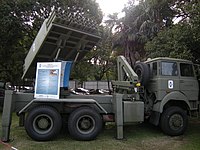
| |
| SLAM VCLC | Multiple rocket launcher | 1 | 105 mm multiple rocket launcher mounted on a VCTAM hull | 
|
Anti-aircraft systems
| Name | Type | Quantity | Origin | Notes | Photo |
|---|---|---|---|---|---|
| Hispano Suiza GAI B01 | 20 mm anti-aircraft gun | 230 | Being automated | ||
| Bofors L/60 | 40 mm anti-aircraft gun | 262 | 
| ||
| L90 twin cannon | 35 mm anti-aircraft gun | 38 | 
| ||
| RBS 70 | Surface-to-air missile system | 12 | To be acquired | 
| |
| Roland | surface-to-air missile system | 3 | will be replaced by the RBS 70 | 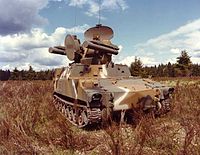
|
Armored vehicles
Tanks
| Equipment | Origin | Type | Quantity | Notes | Photo |
|---|---|---|---|---|---|
| TAM | Medium tank | 250 | Modernised by Elbit Systems, with new gun stabilizing systems. | 
| |
| SK-105 Kurassier | Light tank | 112 | 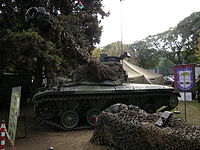
| ||
| AMX-13/105 | Light tank | 50 | Being phased out in favour of the Patagon | 
|
Infantry fighting vehicles and Armored personnel carriers
| Equipment | Origin | Type | Quantity | Notes | Photo |
|---|---|---|---|---|---|
| Panhard AML-90 4x4 | Light Armored car/reconnaissance | 47 | 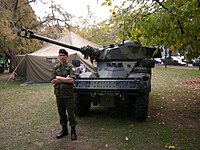
| ||
| AMX-13 VCPC | Armored personnel carrier | 30 | 
| ||
| VCTP | Infantry fighting vehicle | 216 | IFV variant of the TAM. Tank turret replaced with a turret mounted 20mm autocannon | File:TAM VCTP -1.jpg | |
| M113 | Armored personnel carrier | 500 | Including variants (M577,M106,M548,...) | 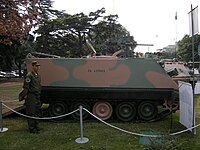
| |
| WZ551 6x6 | Armored personnel carrier | 35 | Will be used in UN peacekeeping in Haiti. | 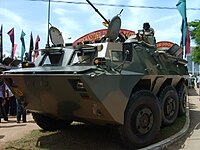
| |
| VBTP-MR 6x6 | APC/Infantry fighting vehicle | 0 | 14 on order. | 
|
Support vehicles
| Name | Type | Quantity | Origin | Notes | Photo |
|---|---|---|---|---|---|
| Lohr Fardier | All terrain vehicle | 50 | For use by Paratrooper Brigade | ||
| M151A2 MUTT | Light Utility Vehicle | 340 | 
| ||
| Mercedes-Benz MB 230G | Light Utility Vehicle | 1000 | 
| ||
| Isuzu Trooper | Light Utility Vehicle | 147 | 
| ||
| VLEGA Gaucho | Light Utility Vehicle | 30 | Currently awaiting "civilian homologation" (legal issues). About to enter active duty. Project interaction with Brazil stopped as of 2011. The only user is now the Argentine Army. | 
| |
| Humvee | Light Utility Vehicle | 69 | For use in UN peacekeeping missions | 
| |
| Agrale Marruá | Light Utility Vehicle | 30 | Use in UN peacekeeping missions | 
| |
| Ford F-Series | Light utility truck | 485 | These Ford Trucks were locally built in Argentina by Ford de Argentina SA | 
| |
| Chevrolet M1008 | Light utility truck | 70 | 
| ||
| Mercedes-Benz MB 1112/1113/1114 | 790 | These MB Trucks were locally built in Argentina by Mercedes Benz Argentina SA | 
| ||
| Mercedes-Benz MB 1720 | 100 | These MB Trucks are built by Mercedes Benz do Brasil Limitada. | 
| ||
| Mercedes-Benz Unimog U-416/421/431 | Light Tactical Wheeled Vehicle | 2000 | 
| ||
| FIAT 697 | Heavy equipment transporter | 20 | These FIAT Trucks were locally built in Argentina by FIAT local Factory |
Aircraft
| This section is empty. You can help by adding to it. (April 2014) |
See also
References
- ^ International Institute for Strategic Studies: The Military Balance 2012, p.370
- IISS 2010, pp. 64–67
- Hugo Moreno, Le désastre argentin. Péronisme, politique et violence sociale (1930-2001), Editions Syllepses, Paris, 2005, p.109 Template:Fr icon
- BuenosAiresNews.net: Argentina reveals secrets of 'dirty war'
- Paul H. Lewis, Guerrillas & Generals: The "Dirty War" in Argentina, Praeger Paperback, 2001, p. 126.
- John Keegan, World Armies|page=22, Macmillan, 1983
- TUCUMAN 1975: Avión del Ejército Argentino es derribado con ametralladoras antiaéreas
- l commando general del Ejército procederá a ejecutar todas las operaciones militares que sean necesarias a efectos de neutralizar o aniquilar el accionar de los elementos subversivos que actúan en la provincia de Tucumán Template:Es icon
- Decree No. 261/75. NuncaMas.org, Decretos de aniquilamiento.
- Facts on File, p. 126 (1975)
- English, Adrian J. Armed Forces of Latin America: Their Histories, Development, Present Strength, and Military Potential, Janes Information Group, 1984, p. 33
- Martha Crenshaw (1995). Terrorism in Context. p. 236. ISBN 978-0-271-01015-1.
- "Argentina to answer rebels 'with the language of guns'", The Montreal Gazette, 8 October 1975
- "Argentine troops rout rebel raid", Sydney Morning Herald, 7 October 1975
- Guerrillas & Generals: The "Dirty War" in Argentina, ibid
- Troops fight off guerrillas, The Rock Hill Herald, 22 December 1975
- Monte Chingolo: Voces de Resistencia
- "ARGENTINA: Hanging from the Cliff". Time Magazine, Monday, 5 January 1976
- Police fight off guerrillas in Argentina; 56 killed, The Windsor Star, 24 December 1975
- "Argentine theatre hit by bomb" The Spokesman-Review 31 December 1975
- Conclusion of Marie-Monique Robin's Escadrons de la mort, l'école française Template:Fr icon
- MM. Giscard d'Estaing et Messmer pourraient être entendus sur l'aide aux dictatures sud-américaines, Le Monde, September 25, 2003 Template:Fr icon
- « Série B. Amérique 1952-1963. Sous-série : Argentine, n° 74. Cotes : 18.6.1. mars 52-août 63 ».
- RAPPORT FAIT AU NOM DE LA COMMISSION DES AFFAIRES ÉTRANGÈRES SUR LA PROPOSITION DE RÉSOLUTION (n° 1060), tendant à la création d'une commission d'enquête sur le rôle de la France dans le soutien aux régimes militaires d'Amérique latine entre 1973 et 1984, PAR M. ROLAND BLUM, French National Assembly Template:Fr icon
- Argentine : M. de Villepin défend les firmes françaises, Le Monde, February 5, 2003 Template:Fr icon
- vehículos Norinco de reciente provisión
- Jane's Defence Weekly 2 February 1991
- Coronel Mayor y Comodoro de Marina
- Jones, Richard (2009). Jane's Infantry Weapons 2009-2010. Jane's Information Group. pp. 896–898. ISBN 0710628692.
- ^ "Light Arms Production in Latin America" (PDF). FAS.org.
- Argentina; Surplus M109 155mm sought, M56 105mm ordered - Dmilt.com, 21 December 2013
- ^ Army of Argentine plans to purchase OTO-Melara MOD-56 light howitzers and M109 155mm howitzers - Armyrecognition.com, 21 December 2013
- ^ Armamentos e Munições Exército Brasileiro. Centro de Comunicação Social do Exército. Retrieved on May 4, 2007. Template:Pt icon
- http://www.ejercito.mil.ar/sitio/_noticias/noticia_full.asp?Id=2816
Bibliography
- International Institute for Strategic Studies; Hackett, James (ed.) (2010-02-03). The Military Balance 2010. London: Routledge. ISBN 1-85743-557-5.
{{cite book}}:|author2=has generic name (help)
External links
| Armed forces of Argentina | |
|---|---|
| Leadership | |
| Other | |
| Armies of the Americas | |
|---|---|
| Sovereign states | |
| Dependencies and other territories | |






